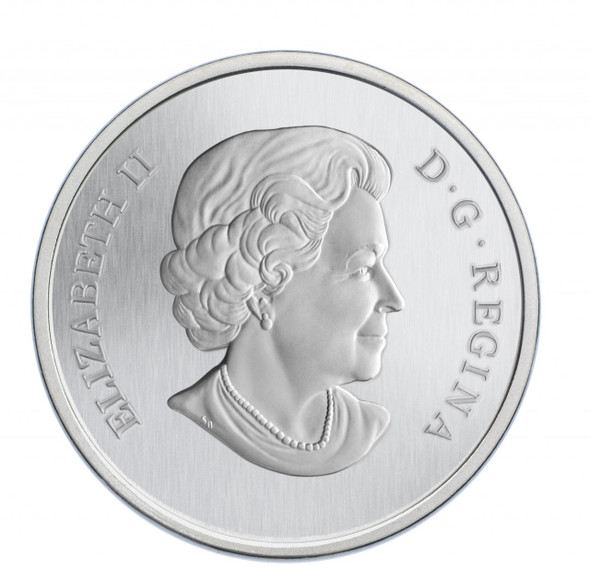Description
Theme
Canadians in nearly any region of the country can see this denizen of populated areas pulling worms from lawns and perched on high, singing its variety of lovely songs, throughout the country’s warmer months.
Description
This painted cupronickel coin has a diameter of 35 millimetres. The reverse image, designed by Canadian artist Trevor Tennant, features a painted orange-breasted American Robin, viewed from its right side with its head looking back over its left wing. The image presents the bird’s bright coppery breast feathers and grey head and wing feathers to stunning effect, as well as the Robin’s bright yellow bill and large black, white-rimmed eye. Its long graceful talons clutch the branch of an apple tree. The tree’s soft pink blossoms with light yellow-green centres contrast prettily with the American Robin’s bright breast. The reverse is engraved with the word “CANADA,” the date “2013,” and the face value of “25 CENTS.” The obverse features the effigy of Her Majesty Elizabeth II by Susanna Blunt.
Special Features
- The 11th coin in the Royal Canadian Mint’s renowned Birds of Canada series, this painted coin beautifully portrays the gorgeous colouring and wing detail of the much-beloved American Robin.
- An exceptional addition to any nature-focused or Canadiana collection.
- A beautiful gift for people who love birds, natural imagery, exquisite natural artwork, and Canadian themes.
Product specifications:
Face Value: 25 cents
Mintage: 17,500
Composition: Cupronickel
Diameter (mm): 35
Edge: Plain
Finish: Specimen
Certificate: Serialized
Artist: Trevor Tennant
Packaging:
Coin is encapsulated and presented in a Royal Canadian Mint branded maroon clamshell case lined with black flock and protected by a black sleeve.
Complete Certificate Text:
Canadians’ Garden Companion: The American Robin
Sleeping near an open window in springtime is a sure way to hear the melodic song of one of Canadians’ favourite birds: the American Robin (Turdus migratorius). When you drift off in the evening, the Robin’s call is likely to be the last you hear. When you wake up, it is usually the first.
Though early colonists, perhaps wistfully, named it for the European Robin, the American Robin is actually North America’s largest thrush. The orange-breasted bird’s calls and songs are one of its most distinctive features. Males tend to be the more vocal of the species, singing from high atop trees early in the morning and as part of the American Robin’s elaborate courtship rituals.
Although it originally inhabited primarily the forest clearings of North America, the American Robin has become one of the few species to have benefitted from urbanization. The growth of large swathes of open fields and lawn, accompanied by treed gardens and parks in residential areas, has actually created habitat for the species, giving it easy access to its preferred diet of fruit, berries, and invertebrates like worms and grubs.
American Robins can form roosting groups of more than 200,000, though their roosts generally include only a few dozen to a few hundred birds. The males, in particular, engage in this behaviour both on wintering grounds in the southern United States and northern Mexico and in its summer breeding territory across Canada and the United States. Although the American Robin is a migratory bird, it will stay year-round in regions whose climate remains temperate. Although they almost always return to the same breeding area, Robins’ path south is not set and seems to reflect the availability of food in a given year. In general, the migration south from Canada occurs in October.
The American Robin bears two to three clutches of light blue eggs per breeding season, generally beginning in April or early May. Both parents work together to feed their chicks about 40 times per day. Sometimes clutches by the same mother will overlap (the second clutch housed in a separate nest), even before the first group of three or four chicks is ready to leave its nest. In this case, the father may take over primary care of the first group of chicks.
The Coin
This painted cupronickel coin has a diameter of 35 millimetres. The reverse image, designed by Canadian artist Trevor Tennant, features a painted orange-breasted American Robin nestled on the branch of a flowering apple tree. The reverse is engraved with the word “CANADA,” the date “2013,” and the face value of “25 CENTS.” The obverse features the effigy of Her Majesty Elizabeth II by Susanna Blunt.
















